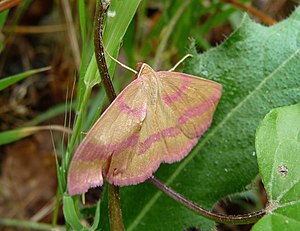Broomstick Rotbandspanner
| Broomstick Rotbandspanner | ||||||||||||
|---|---|---|---|---|---|---|---|---|---|---|---|---|

Broom-broom-red ribbon tensioner ( Rhodostrophia calabra ). Attention: The picture shows a crippled specimen with deformed and torn front wings. |
||||||||||||
| Systematics | ||||||||||||
|
||||||||||||
| Scientific name | ||||||||||||
| Rhodostrophia calabra | ||||||||||||
| ( Petagna , 1786) |
The broom-broom-red ribbon spanner ( Rhodostrophia calabra ), also called broom-broom-red-rimmed spanner or yellowish red ribbon spanner , is a butterfly ( moth ) from the spanner family (Geometridae).
features
The male moths reach a wingspan of 28 to 33 millimeters; the females are slightly larger at 28 to 35 millimeters. The basic color is ocher or light brown with a slight olive shade, with the hind wings becoming significantly lighter towards the costal edge. The drawing elements are purple-red, in the subspecies separata also brown-red. The internal transverse line is clearly developed on the forewing; but it is absent on the hind wings. Around the place of the outer transverse line is a transverse bandage, the distal and proximal boundaries of which are almost always clear and very sharp. However, the space in between can be kept in the basic color or completely filled with purple. The inner transverse line is regularly curved, the outer transverse band, however, is often slightly wavy or slightly jagged. The hemline and the fringes are also purple, and the purple area occasionally extends to the distal hem area. Discal spots are mostly absent in the nominate subspecies , but are mostly present in the other two subspecies.
The elongated egg is initially bluish and later turns reddish.
The caterpillar is relatively very slender and tapers a little towards the front end. The segments are relatively long. It is blue-gray, brown-gray to yellow-brown in color. The dark back line is loosened up by lighter spots. The top has small, light-colored warts that are covered with short black bristles.
The pupa is relatively slender and yellow-brown in color. It has light yellow wing sheaths and a dark back line.
Geographical distribution
The common broom spider is mostly native to southern Europe. The distribution area stretches from the Iberian Peninsula in the west, next to a small isolated occurrence in North Africa ( Morocco ), over southern France, the western and southern Alps, Italy (with the exception of the Po Valley ), the eastern Adriatic coast to the southern Balkan peninsula . In Central Europe there are only a few isolated occurrences in Central France and Rhineland-Palatinate. It is absent on the larger Mediterranean islands (Corsica, Sardinia, Balearic Islands, Sicily and Crete). In the Balkans, an isolated occurrence is also known to the north of it in the border area of northern Bulgaria / Serbia. A larger, disjoint occurrence is found on the eastern Black Sea coast of Turkey and the Caucasus region. On the Iberian Peninsula and North Africa, the nominate subspecies is represented by the subspecies Rhodostrophia calabra separata . The moths of this subspecies are a bit smaller on average. The basic color is lighter and the drawing elements are more brownish red than purple. In the Caucasus region and in eastern Turkey, the subspecies Rhodostrophia calabra transcaucasica occurs instead of the nominate subspecies . It always has clear discal spots.
habitat
The species occurs only in dry, warm habitats . In the Mediterranean countries this is e.g. B. the maquis , loose oak forests with plenty of gorse bushes. In the vertical, the type occurs from sea level up to about 1000 meters, exceptionally also up to 1600 meters. On the Iberian Peninsula, the subspecies Rh. Calabra separata rises up to 2000 meters.
Way of life
The broom broom is univoltin , which means that only one generation is formed per year. The moths fly from mid-May to late June, in the lower areas of the Iberian Peninsula as early as mid-April, and in the southern and western Alps often not until late May to late July. The moths are diurnal and nocturnal. They can easily be roused when they rest.
The caterpillars mainly feed on legumes ( Fabaceae ). The following are proven to be host plants: Common broom ( Cytisus scoparius ), gorse ( Genista ), mainly dyer's gorse ( Genista tinctoria ), cheekbones ( Dorycnium ), scabiosis ( Scabiosa ), dock ( Rumex ), knotweed ( Polygonum ), thyme ( Thymus ) and thyme ( Thymus ) and thyme Meier ( Asperula ). The caterpillar overwinters, pupation takes place in spring in a light web.
Systematics
The species was first scientifically described in 1786 by Vincenzo Petagna under the binomial Phalaena calabra . Later, under the names Phalaena trifasciata Cyrillo, 1787, Aspilates taeniaria Freyer, 1834 and Rhodostrophia calabraria var. Muscosa Bastelberger, 1908, which are more recent synonyms . There are currently three subspecies: the nominotypical subspecies Rhodostrophia calabra calabra Petagna, 1786, Rhodostrophia calabra transcaucasica Prout, 1920 (in the Caucasus region and eastern Black Sea coast of Turkey) and Rhodostrophia calabra separata Prout, 1935 (Iberian Peninsula).
Danger
The species is endangered in Germany. However, it has probably always been relatively rare and restricted to Rhineland-Palatinate. The previously reported occurrences in Baden-Württemberg have proven to be incorrect determinations.
swell
Individual evidence
- ↑ a b see red lists at science4you
- ↑ Günter Ebert (Ed.): The butterflies of Baden-Württemberg Volume 8, Nachtfalter VI (Spanner (Geometridae) 1st part), Ulmer Verlag Stuttgart 2001. ISBN 3-800-13497-7
literature
- Walter Forster , Theodor A. Wohlfahrt : The butterflies of Central Europe. Volume 5: Spanner. (Geometridae). Franckh'sche Verlagshandlung, Stuttgart 1981, ISBN 3-440-04951-5 .
- Axel Hausmann: The Geometrid moths of Europe, 2nd Sterrhinae. Apollo Books, Stenstrup 2004, ISBN 8-788-75737-4